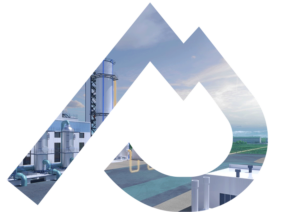
CO2 Utilization:
a path to carbon neutrality
As part of a circular economy approach and prior to storage, CO2 can be used in the fabrication of products such as synthetic fuels or e-fuels. Its reutilisation is a route to decarbonisation for business sectors such as air and sea transport. It is also part of the transformation of the chemical industry into green processes.
Introducing CO2 reutilisation:
toward synergy with the hydrogen industry
Three ways of exploiting captured carbon exist and offer virtuous conversion of the uncompressible residues of greenhouse gas (GHG) emissions from industry:
- The direct use of CO2 (for its physical properties) plays a role in the production of solvents and other solutions (as an alternative to the oil industry), but also in water treatment or agribusiness techniques (cryogenics).
- Biological CO2 reutilisation (by transformation) uses green methanation and organic fermentation technologies to create renewable energy.
- Chemical CO2 reutilisation (by transformation) remains the most promising option, and uses residual carbon dioxide as a raw material integrated into various thermochemistry, mineralisation, electrolysis, photocatalysis, organic synthesis and hydrogenation processes.
Within the Pycasso project, an association with the hydrogen industry is taking shape around the production of synthetic methane and renewable fuels (e-fuels), to optimise the reutilisation of CO2. The captured carbon dioxide can be used for production of the e-fuels (developed from decarbonised hydrogen and CO2), for which the aviation industry has longed.
Understanding CO2 reutilisation
CO2 arising from capture can be used in the production of low-carbon fuels, chemicals and materials. The Pycasso project is particularly aimed at reutilisation in association with the hydrogen industry. Indeed, H2 combined with captured CO2 offers prospects that could become part of a virtuous circle, needed to achieve carbon neutrality by 2050.
One of the aims of CO2 reutilisation is to substitute it for fossil fuels, through the process of creating biogas and DME (dimethyl ether) biofuels, methanol and synthetic diesel. These second-generation energy sources and fuels, derived from biomass, are a sustainable source of energy, allowing significant reductions in GHG emissions, to help the climate.
The sea and air travel sectors are among the most polluting and therefore urgently need to find solutions to lower their volume of GHG emissions. Production of the methanol needed for the development of e-fuels (electrofuels such as e-kerosene) is what these industries are waiting for.
It is the main large-scale reutilisation pathway associated with the Pycasso project at present. However, there is a broad spectrum of possible applications for CO2 reutilisation. It also has a place as a raw material for the production of polycarbonates, ethylene or aspirin, for example, as well as for the production of carbonated raw materials, and more marginally as a refrigerant fluid or gasifier for drinks.
Every innovation arising from CO2 reutilisation indirectly affects individuals. New fuels, chemicals or carbonated products, such as concrete, deliver benefits in terms of reducing GHGs. The population is therefore involved in the virtuous circle of using captured carbon dioxide, as an end consumer within a circular economy.
The aim is to optimise the chain, collecting the CO2 and sending it directly to reutilisation sites, via the network of pipelines. Thus only the residual quantities will be stored in the territory. There are therefore many areas to research for the development of reutilisation pathways over the coming years.
